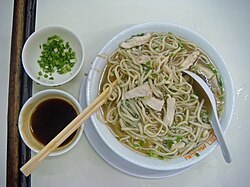Mami soup
 Chicken mami of Masuki restaurant | |
| Type | Soup |
|---|---|
| Place of origin | Philippines |
| Main ingredients | Noodles, chicken |
Mami (pronounced: MAH-mee) is a popular Filipino noodle soup made with wheat flour noodles, broth and the addition of meat (chicken, beef, pork) or wonton dumplings. It is related to the pancit class of noodle dishes, and the noodles themselves are sometimes called pancit mami.
Origin
Its creation is generally attributed to Ma Mon Luk, a Chinese immigrant to the Philippines who began selling noodles served with chicken broth and chicken meat in Binondo, Manila in 1920. He originally worked as an ambulant vendor, carrying the food in two metal vats on a pole much like taho vendors. Thus, mami was originally street food, but with the success of his business, Ma eventually opened up an eatery and ultimately a chain of restaurants bearing his name. As a street vendor, Ma originally called his dish "gupit", after the Tagalog word for “cut”, because he would cut the noodles and chicken with scissors. He later decided to call the dish "Ma mi" (simplified Chinese: 马面; traditional Chinese: 馬麵; Cantonese Yale: Máh-mihn; Pe̍h-ōe-jī: Má-mī; lit. 'Ma’s noodles'). However, Ma did not have the name trademarked. Soon, imitation noodle soups sprouted with a name that was, personally, his.[1][2][3]
However, the claim that Ma invented the mami, which originates from the media company ABS-CBN, is likely untrue. According to linguist Gloria Chan-Yap, mami is Fujianese in origin, not Cantonese; in Philippine Hokkien literally means "meat noodles" (simplified Chinese: 肉面; traditional Chinese: 肉麵; Pe̍h-ōe-jī: Mah-mī). Like the siopao, the noodle dish already existed in Filipino-Chinese cuisine before Ma popularized his version.[4]
See also
References
- ^ Gao Min Chuan, The Story of Mami King, Ma Mon Luk, Zhongshan Overseas Chinese Journal, April 1, 2010
- ^ Rodriguez, Anna Katarina (2012). Southeast Asian Personalities of Chinese Descent: A Biographical Dictionary, Volume 1. Singapore: Institute of Southeast Asian Studies. pp. 736–738. ISBN 978-981-4345-21-7.
- ^ Jose Victor Z. Torres, The Legend of Ma Mon Luk, Rogue, April 2017
- ^ De Leon, Adrian (2016). "Siopao and Power: The Place of Pork Buns in Manila's Chinese History". Gastronomica. 16 (2): 45–54.

